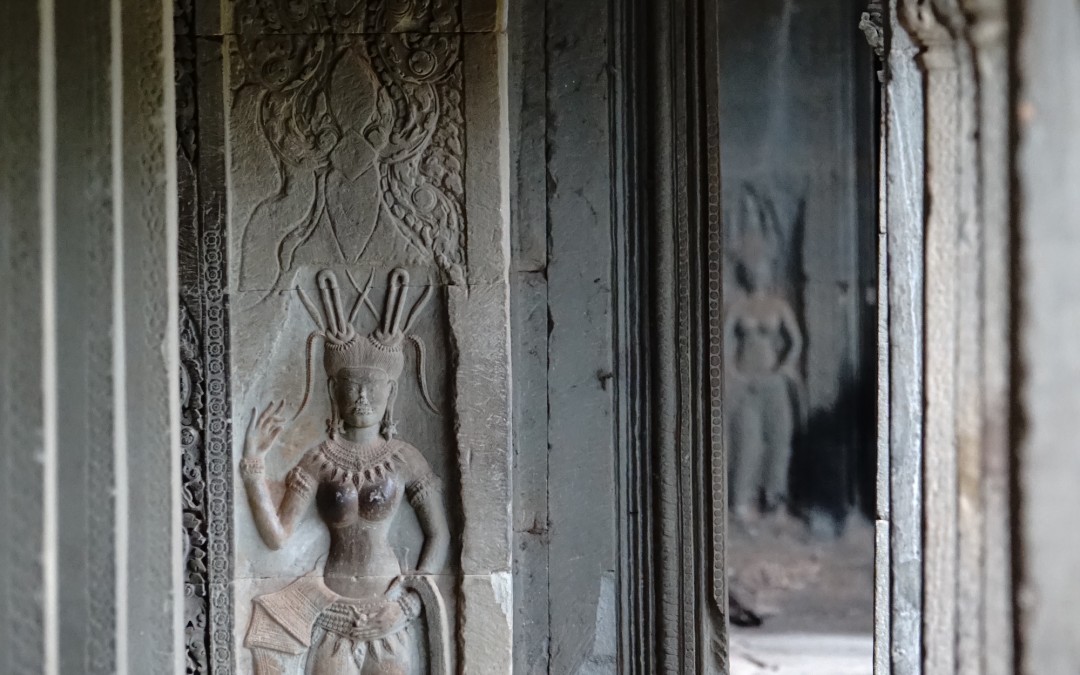
by Nick | Aug 16, 2019 | Angkor, Blog
The Churning of The Sea of Milk
The bas-reliefs on the walls of Angkor Wat are perhaps the pinnacle of Khmer Art. The carvings 2 meters high, stretch for a staggering 600 meters around the temple and depict scenes from the great Hindu stories, including the phantasmagorical if fundamental Churning of The Sea of Milk, which goes something like this;
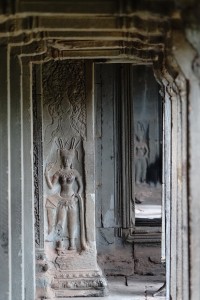 The outer corridor alongside the Churning of the Sea of Milk
The outer corridor alongside the Churning of the Sea of Milk
The Gods and Demons decided they had had enough fighting and it was looking like they were going to destroy the world so they went to Vishnu for advice.
Vishnu suggested they put all the medicine they could lay their hands on into the Sea of Milk to create the elixir of life that would bestow indestructibility amongst many other amazing things to whoever drank it, then have a big tug of war to see which lucky team got the joy juice.
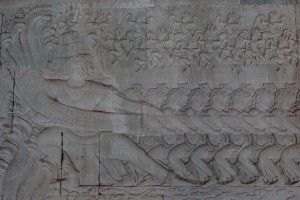 Ravana an Assura (demon) with the head of Vasuki (snake king)
Ravana an Assura (demon) with the head of Vasuki (snake king)
The recipe for Amrita as the elixir of life is known, goes something like this; take one ocean and churn thoroughly with a celestial blender until the ocean thickens, a thousand years is suggested. A good test of when you’re getting close is buxom Apsara or nymphs will start to evaporate from the seminal waters.
But what could they use for a blender. A rope that hundreds maybe thousands of hunky Demons and Gods could tug on and something to tug round was needed. The serpent that lived at the bottom of the ocean of course, actually he was Vasuki king of the snakes and Mount Mandara.
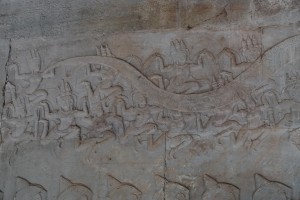 Buxom nymphs or Apsara arising out of the seminal fluid in anticipation of amrita
Buxom nymphs or Apsara arising out of the seminal fluid in anticipation of amrita
The Demons got the head* and the Gods the tail and they tugged for a thousand celestial years (which is a very long time), round the mountain in the middle of the ocean.
*Read on to find out why Vishnu tricky as ever and it has to be said a little biased in favor of the Gods had advised them to take the tail end and leave the head to the demons.
They tugged so hard that the mountain sank. Vishnu in his second reincarnation (there were ten in total) came to the rescue as a convenient and rather large tortoise lifting up the mountain on his back.
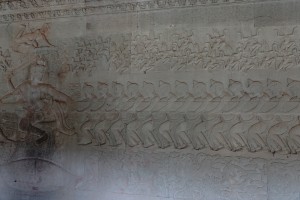 Vishnu sitting on his avatar (reincarnation) the Turtle encouraging the tugging Divas (Gods)
Vishnu sitting on his avatar (reincarnation) the Turtle encouraging the tugging Divas (Gods)
Meanwhile Vasuki, the king of snakes was getting pretty fed up of being tugged by hunky Gods and Demons for a thousand celestial years. Exhausted he sprayed the Demons (since they’d got the head) with halahala that was definitely not going to bring joy to the juice, there was also the small matter of destroying creation.
Shiva to the rescue, he sucked up the halahala thus saving creation and the rather wingy Gods but in the process got a sore throat and turned blue. His wife Parvati was so alarmed that she used Shiva’s chariot to dig a lake, which cooled his throat.
Anyway that’s about the end of the story. It seems in the end everyone was happy and there was enough joy juice to go round. The Gods got lots of divine nymphs while the demons got the grumpy goddess Varuni, who had a bit too much halahala. Vishnu got a new wife Lakshmi and Shiva, now recovered got a moon to wear on his head.
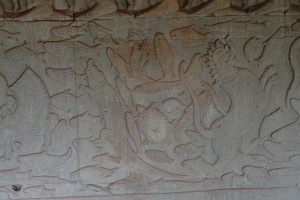 All the creatures of the ocean getting churned in the Sea of Milk
All the creatures of the ocean getting churned in the Sea of Milk
Another ending to these celestial shenanigans was that as the thousand years stated in the recipe were up and the ocean turned into the elixir of life. There was much singing and dancing. Apsaras flew up from the waters and white elephants trumpeting the occasion also had a go at flying.
The Gods, Demons and cosmic blender, Vasuki had done their job turning the ocean into joy juice now born in an urn by a heavenly physician. Quick as flash the demons grabbed the urn from the Doctor’s arms and were about to drink when the most beautiful girl in the world appeared.
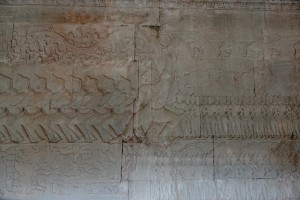 Hanuman, the monkey god making sure the Divas keep tugging
Hanuman, the monkey god making sure the Divas keep tugging
Will you give me anything I want? She pouted her lips and thrust out her bosom, anything, anything, they cried. Will you give me your joy juice? We will we will, they sighed exhausted. Snatching the moment the beautiful girl, actually Vishnu, gathered up the elixir of life and scarpered over to the Gods, who rubbed whatever Gods rub in anticipation of their impending transformation. They were already Gods so I’m not sure what they were getting transformed into but they were very happy.
This ‘story’ doesn’t end there because the Demon Rahu, who knew what a tricky character Vishnu was, that is if you were a demon. Had managed to get a quick slurp of the amrita but not before he’d been spotted by the sun and moon who told Vishnu what he was doing. Vishnu now back in his chiseled form cast his discus to cut off Rahu’s head. Rahu had managed to get in a quick sip but hadn’t swallowed yet so while his head was impervious to the oiled God’s manly manipulation of his orb, Rahu’s body died.
Not one to forget a grudge Rahu or his head had it in for the Sun and Moon and plunged the world into darkness but his bark was worse than his bite so the Sun and Moon laughed at him and moved out of eclipse.
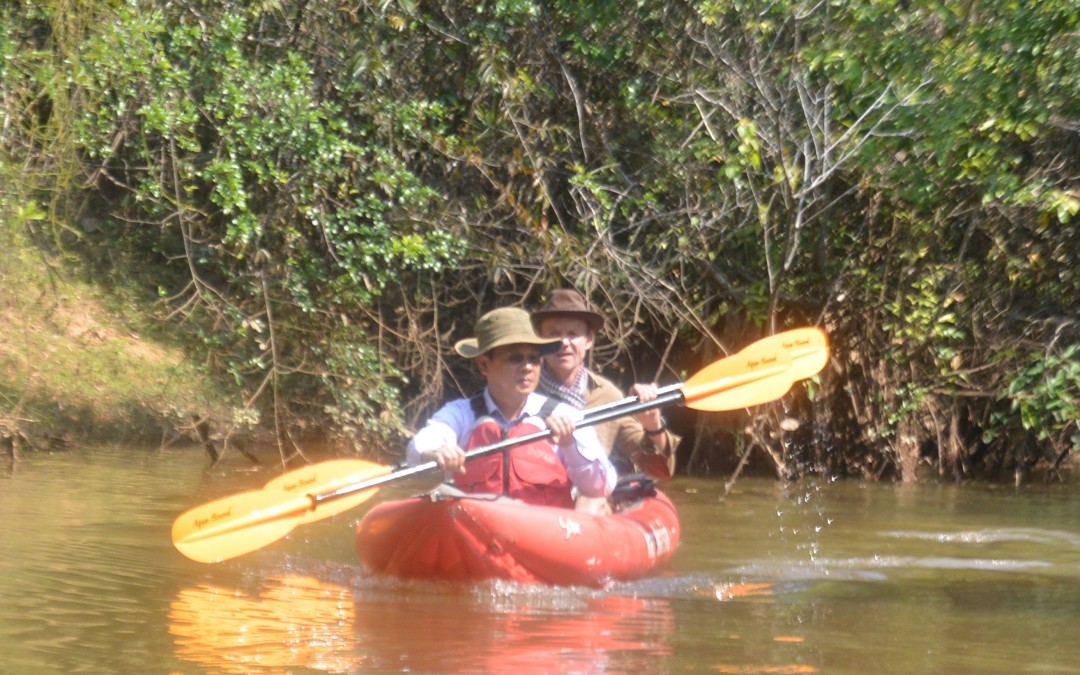
by Nick | Aug 6, 2019 | Angkor, Blog, Kayak
Background
The rise and fall of the Angkorian Empire, which lasted nearly 600 years from the 9thto the 14th century, was centered in what is now Siem Reap Province, around its greatest religious monument Angkor Wat. The metropolis of Angkor comprising nearly a million people covered a thousand square kilometers servicing what remained the largest city in the world until London eclipsed it seven hundred years later.
 Angkor Thom Moat, one of the great waterways that maintained ground water below the temple and prevented subsidence
Angkor Thom Moat, one of the great waterways that maintained ground water below the temple and prevented subsidence
Key to the success of the civilization was the management of water in a region of inundation and drought. An elaborate system of canals and barays or reservoirs channeled water from the Kulen Hills to the North into the city bringing food security in the form of rice and flood mitigation during the monsoon.
The availability of water ensured that food went in and shit went out. Canals facilitated the construction of the temples conveying the stone from the quarries to the North. And the temples were built with defensive moats that maintained ground water levels preventing subsidence (as well as looking pretty).
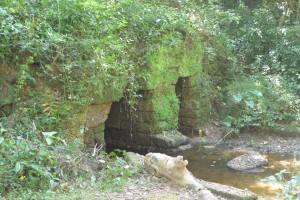 Runta Dev, the tunnel under the 8m high walls of Angkor Thom that channeled waste-water out of the city into the moat
Runta Dev, the tunnel under the 8m high walls of Angkor Thom that channeled waste-water out of the city into the moat
Just as water was the key to the empire’s success it is now thought to be instrumental in its decline. Not long after the death of the great king JVII in 1218 the kingdom was hit with a double whammy. First 30 years of drought followed by exceptional floods, which washed away the elaborate and sophisticated water management system that JVII in particular had built.
In recent years the importance of these systems has been recognized again as the massive increase in tourism has lead to ground water levels falling and the potential collapse of the temples. It is no coincidence that the best preserved are those with functioning moats.
One man has been championing the restoration of the Angkorian water management. His excellency Hang Peou now Director General of Apsara, the authority responsible for managing the UNESCO world heritage site, has overseen the construction of canals that channel the Siem Reap River into the North Baray, the moats of Preah Khan, Ankgor Thom and even Angkor Wat. Reducing the possibility of Siem Reap flooding as it did in 2011. And maintaining the ground water levels that prevent subsidence of the temples.
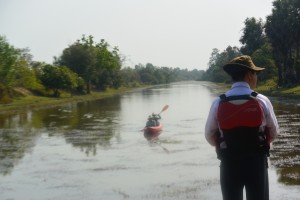 Peou overseeing our progress up the North Baray Channel
Peou overseeing our progress up the North Baray Channel
These small matters aside obviously the most important function of Angkorian hydrology is to allow us to paddle through the Angkor Park, Cambodia’s best preserved 400 km2 of lowland mixed evergreen and deciduous forest.
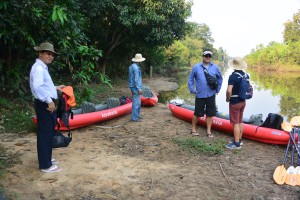 Peou and Jady with Buntha contemplating our adventure
Peou and Jady with Buntha contemplating our adventure
And so it was one Monday morning that Peou, then Director of Water Management at Apsara, facilitated by Jady, a consultant working with Apsara together with Buntha and myself kayaked through the heart of the Angkor Park. Jady and I had previously recce’d Peou’s canal so this time we didn’t get lost and anyway Peou knew the way, but – we hadn’t followed the river as it heads South to the city.
The current had cut deep into the soft ground leaving 7meter high banks that we had to scramble down with our kayaks and then awkwardly get in them*.
*Evidence of the destruction of JVII’s waterworks as floods washed away his canals and gouged deep scars through Angkor.
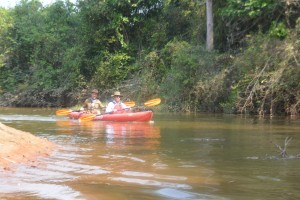 Paddling down the Siem Reap River
Paddling down the Siem Reap River
A few fallen branches had accumulated enough flotsam and jetsam to block the river with no way through but a messy scramble. Jady and Buntha paved the way. Poeu and I made it easy.
There are 700 Angkorian structures inside the Angkor Park but only 180 of them can be called temples, they’re the ones with moats. These monumental stone edifices need solid ground for their structural integrity, without it they crumble to a pile of stones. Siem Reap is a built on a light sandy soil, water gives it substance, which is what the moats do for the temples.
A few hundred meters on either side there were no doubt bus loads of Asian tourists but here in the heart of Angkor we paddled passed explosions of bamboo erupting on either side. White-collared Kingfishers taunted Buntha to catch a photo. A Snake Eagle followed our progress from above, while a Shikra watched us with disinterest from a fallen branch. All manner of other birds sang from the trees on either side obliterating any thoughts of tourists or even other people.
We’d catered for 5 pax kayaking but one of the water management guys came along for the ride so the third kayak was one paddle power short and we had visions of Kosal, Jady’s assistant unable to move his shoulders for a month or 2. They’d had the sense to share the work and caught up beaming and claiming the big adventure.
Our driver had accumulated helpers by the time we reached the sluice gates at the French Bridge (confusingly built by Americans), who pulled us up the steep stairs to Peou and Jady’s vehicles.
It took a while to sink in that we had paddled through one of the wonders of the world, visited by 3 million people but seen none, instead thick riparian forest as if we were discovering it for the first time.
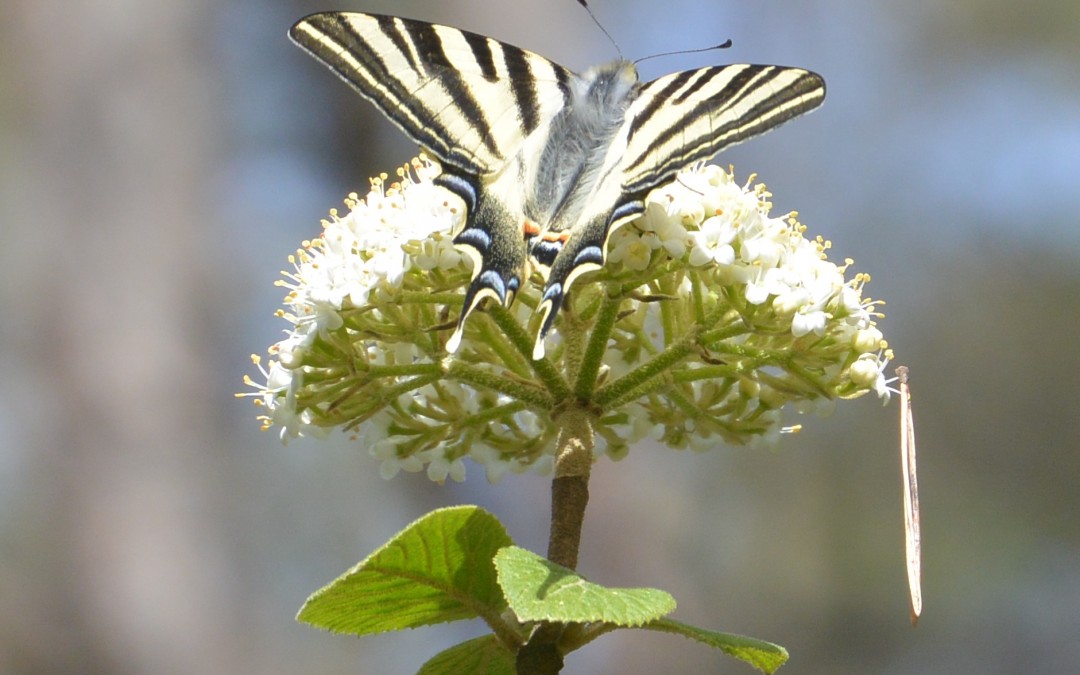
by Nick | Jun 30, 2019 | Blog
Spain May 2019
Panic on the M23, it was shut, Gatwick terminals are panic at the best of times. The plane left on time for my cycling adventure / Spanish sojourn. Pink Prosecco fueled the flight, the stuff of 3rd division footballers wives. Premier league would drink Crystal.
Twenty minutes early but an hour later and no sign of a taxi, certainly not the one I’d booked. I discarded the bike box and managed to load the frame, saddle, two wheels, panniers etc. into the back of an estate car. The driver bit his nails while looking over his shoulder, which wasn’t exactly soothing around midnight. I was even more nervous when he communicated that my hostel was in the middle of Bilbao’s old town, a pedestrian zone. As it turned out only few hundred meters from where he dropped me but it could have been the other side of the moon as I staggered with the above constituents of a bicycle, to my room for the night. Half an hour later I was installed in a shoebox listening to Desert Island disks drinking whisky and restoring sanity.
The Mozart Bar in Miranda de Ebro was busy. Wine was randomly splashed in the direction of customer’s glasses. A flux of townsfolk surged and ebbed as they stopped off on route for lunch. A table of local ladies drinking Cinzano were set for the afternoon.
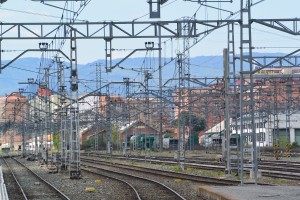 Miranda de Ebro Station
Miranda de Ebro Station
I munched my tapas then went to catch the train pretty much where I came from except a little further North. San Sebastián is only 70km along the coast from Bilbao but no train line has managed to bore through the mountains direct so we came inland then headed back again.
San Sebastian
At the far end of San Sebastián or most distant from the railway station was my hosts apartment block. An ugly building but once you were inside that became irrelevant as you looked back over the bay from my verandah. Nice hosts recommended a bar adjoining a concrete square. Delicious food, I went the next night as well.
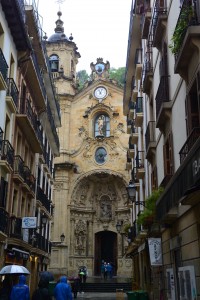
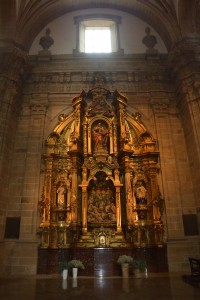
San Sebastian Bay from my apartment block (below). The facade and interior (next page) of The Church of Saint Mary in the old town
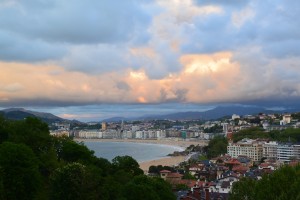
Sodden Sebastián and no strangers at the bar, The Church of Saint Mary and the start of the Santiago de Compostella Pilgrimage from the woods behind the apartment block.
From verdant mountains sheathed in mist and showered with rain to the Atlantic foaming gently on the sandy beach for the benefit of the San Sebastianites. I made my way to the old town and the Church of Saint Mary. A stunning façade and vaulted interior led to crypts with gory religious memorabilia.
As the clouds parted I climbed the hillside behind the apartment block to the start of the pilgrimage trail.
I left my gentle hosts the next day to the the barks of their soppy dog waking up the household at 6am and cycled through the sleepy town. A few people going to work and kids emerging out of nightclubs at daybreak.
No bike the conductress told me. Ok I take the wheels off. It had worked from Bilbao, not so easy here. She eyed me suspiciously and wagged her finger when the saddle still stuck out of the luggage rack. Ok I take the seat off and invited her back to check, grudging acceptance until the process was repeated with a more officious conductress. The train effortlessly pulled out of the station and I and my bike were still on board.
We slowly snaked our way through valleys and under hills cloaked by beech and oak. The first couple of hours were so slow that I was wondering if we’d make it to the other side of Spain and Barcelona. The hills gave way to dusty plains and wind blown balls of scrub rolling across the semi desert like the setting for a spaghetti western. A few scratched fields waited patiently for rain, towns in the middle of nowhere.
Storks peered out of their untidy nests built on chimney tops and pillars beside the railway tracks. We reached Zaragoza, the center of nowhere then the train sped up.
The café bar on the Alvina cross country RENFE semi-high speed train was alive and had the same effect on my sleep deprived self. A beer, a dried ham sandwich and happily back in my seat I watched Spain roll by. Barcelona was just round the corner.
Barcelona
‘You’re very lucky,’ said the German proprietor of the third floor hostel, set in an elegant town house. And I suppose I was with a big spacious room lit by shuttered windows opening onto a balcony ledge above the street below. And as a special favor, since I was so lucky, I could keep my bike in the room. My phenomenal good luck was a little overwhelming.
Like a demon possessed I set upon Barcelona to find a bike box – unsuccessful, the Reich kinder boy dismissed my request as absurd. I found another bike shop – warm, call on Monday. A gym, the gym that I went to when I was staying with Tom in what I reminisced to be a remarkably nice apartment. The bars and restaurants we went to around Avenue Parallel. I’m probably going to have to wrap the Trek – my bike, in a Sargasso Sea swirl of plastic to get it on the plane – Plan B.
Showered and clean I headed back to Av Parallel from my incredibly lucky hostel but didn’t make it and had dinner at a formulaic Spanish restaurant on the main road. It was still good.
Borreda
Bilbao, San Sebastián and Barcelona connected by RENFE great but my stressed itinerary induced paranoia and in turn blotched skin. The distance flies with the gradient but against one kilometer is worth three and this afternoon’s cycle traversed a thousand meters from the station at Ripoll to Borredà Village. A biting wind blew head on as I turned right and North to the mountains and their snow capped peaks.
Species extinction was headline news as we rush headfirst into environmental Armageddon but not here – yet. Within minutes of leaving the main Ripoll road I heard a cuckoo, now absent from Sussex and as the forest closed in and the countryside descended so the stress departed.
 View up the valley from Borreda (It’s pretty countryside)
View up the valley from Borreda (It’s pretty countryside)
A sigh of relief when I got here, that is El Querol Vell a fourteenth century farmhouse in Borredà where I’m staying for the next five days.
The towns seem closed for a lot of the time, their inhabitants guts tuned two hours later than mine. So I’m having tea now I’ve got some when I want dinner, which is at 8.30 or what feels like a midnight feast. Breakfast is 12 hours later at 8.30am and that took some negotiating. Signor El Querol of the same name except as I later found out it was Ignacio, and I became buddies excepting a slight misunderstanding over temperatures. I suggested it was a little above freezing as recorded and shown on the internet, that’s the next valley, the one not supporting Catalan independence I expect.
There’s a box circuit from Borredà to Berga then La Pobla de Lillet where Tom, David and I came off the Haute Pyranees at 1800 meters last year. I remembered the two self-congratulatory beers that were the killer as we had to climb back up again over the fifteen hundred meter pass to get to Sant Jaume de Frontanya and on to Borreda.
This time I stopped to pay respects to the 11th century church that lit up when I stuck a Euro in the slot. Despite this it was a spiritual place; the thousand year old chapel surrounded by a little hamlet and a friendly dog.
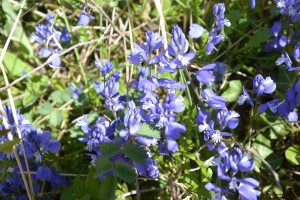
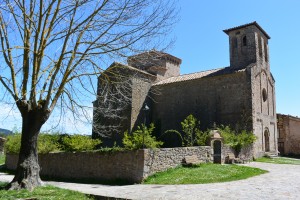
Gentian on the roadside & Sant Jaume de Frontanya
Berga wasn’t in the slightest bit spiritual my first stop on the box circuit but I found some tea. On route was the Embarasment of Balls ok a clumsy slapstick for ?? (Read on) that I rode across to get to Berga. Past Berga I was on B-roads, which allowed for a little wobble when I was looking at the new growth bursting out of the trees.
One place seems to stay open in Catalonia and that’s the bar by the church in the center of the village (Borredà). Anywhere else that one might purloin a service from has only a brief window in their daily calendar allowing the customer the privilege of purchase.
The central bar has a supermarket though the lights have to be turned on from behind the bar and a hardware store but I made do with a couple of Estralla’s, the Spanish beer. Still it wasn’t time for dinner so I watched CNN debating facial recognition in China AKA Huwaei.
Exerting exercise or exercise exertions. Not much sweat in this dry chill environment so soothed and calm if a little extended, restored by being here but eventually dinner is served. What can I do when I’m exhausted? Read a book. I am but it’s disturbing and provocative. Adam should be the dream companion; hunky, beautiful, programmed for sex, biddable but is he? A robot, but when the main character try’s to turn him off Adam breaks his wrist. Way more complex with many issues examined but central to the story is what do we want and when we get it what are the consequences.
I walked through mixed pine-woods along the GR4 long distance footpath, which continues to the French side of the Pyranees. The countryside rang with the sound of birds. Species long declined in the UK. Apart from the sound of cuckoos and the crested tit I saw yesterday, a treecreeper and an eagle, its brown plumage was a disguise, like a cloak over its shoulder.
An 11th century chapel, Saint Sadurni de Rotges. In the middle of nowhere like Saint Jaume yesterday but also still used.
Terraces where once there was agriculture, now glades of trees. Wire fences hung with signs warning Reserva de Caca’s, no hunting I understood. My hackles rose but it gives this mainly or recently unspoilt landscape a purpose and belongs to someone, so it has a chance of preservation. Huge cement works on the way to Guadiole with a fantasy castle for the owner, like the Brecon Beacons in Wales now depopulated and reverting back to nature. And everywhere the yellow flags for Catalan independence.
True to form Vilada was shut. Visions of a non-sandwich lunch faded as the village came to an end with no apparent restaurant but there was a bar. And a little supermarket so lunch was grapes, chocolate and beer more than made up for by the view over the town from the top of the hill.
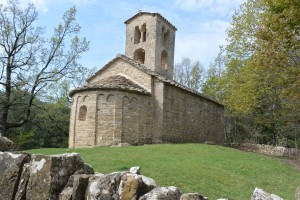 Saint Sadurni de Rotges
Saint Sadurni de Rotges
Walk tall like a lobster. Some bizarre story David, my brother had told me from a self-help book no doubt designed to make him rich. Lobsters don’t walk they sort of scuttle, not helped by having disproportionately large claws get in the way. I think it meant stand up straight so I shrugged the fatigue from my shoulders and strode into town.
Trains, buses, roads, electricity though we had a power cut, sportive zona industriel all thrown at the Catalans as a sop but it sort of makes it worse. Judging from very brief and ill informed observations that maybe this is not the most broad minded or educated region. It feels like everyone’s each other’s cousin when you walk in a bar.
There’s a village not far from Berga called Baga so when you see a sign pointing towards Baga Berga you wonder if anyone has a sense of humor.
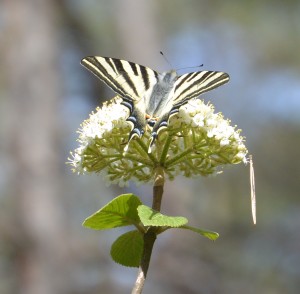 A Swallowtail butterfly
A Swallowtail butterfly
I was getting close, the man in the bike shop in Berga found a bike bag – on his computer, that’s what you want, he stated proudly, Yes I said ruefully. I called the Aryan nation AKA Barcelona bike shop, who said they had a consignment of bikes being delivered so would have a bike box, when?
A piece of piss, I thought bathed in the arrogance of my recently returned cycling fitness as I spun my way basically down hill to the Emballisment de Baels (see before). There’s a little bit of hill into Berga but then it’s a big road beside the reservoir to where I was going to turn off on D roads to La Nou.
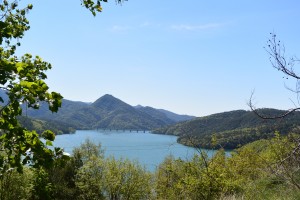 Emballisment de Baels
Emballisment de Baels
The road up to the Village of La Nou was steep, not for very long but on a par with the pass to St Juan so I admired the old guy (older than me!) with calves like wire hausers powering up the hill. His face was grimaced in what appeared to be agony so I couldn’t imagine he was enjoying himself but then maybe I look like that.
Of course today when I bought my picnic in Berga to have in the mountains of Nou (La Nou de Bergueda) each bar I went into on route, two in fact, appeared to offer delicious things for lunch and my picnic was anything but; a mango rotten in the middle, a bottle of vinaigrette purporting to be rose, flannel bread and a tasteless tomato. There was some quite nice cheese.
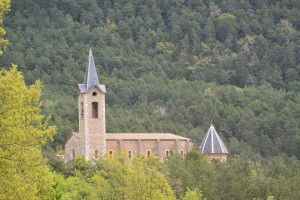 The Church at La Nou
The Church at La Nou
I had my compromised lunch with a massively muscled bull, whispering sweet nothings in the ears of his bell clad cows in an alpine meadow. I know she’s pretty but your clang is more alluring he snorted at another bovine beauty.
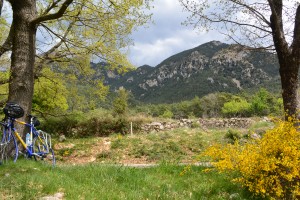 In the mountains of Nou with my Trek
In the mountains of Nou with my Trek
Grhcargh very fast, that’s how Catalan sounds when the boys in the big boots talk in the bar, which filled a little of the yawning gap of time between what was reasonable for exercise and finally dinner. In between Estrella’s I thought about the silver ring that I wear. It’s silver because I’ve got a silver relationship, beautiful but not as good as gold. I was thinking about bringing Manus here – as in Spain. We’d have to sort out food, rice especially but the countryside and El Querol, Laor Na! (Very good in Khmer).
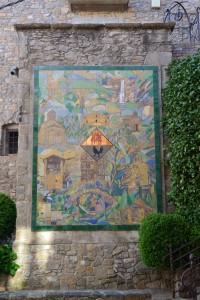 Borreda and its history on a mural in the centre of the village
Borreda and its history on a mural in the centre of the village
Talking of which, or not, Ignacio formerly known as El Querol is triggering my nascent French, not that there’s much nascent-cy but its better than a complete absence of Spanish.
A one hundred kilometer circuit South of Borredà and Berga. I came here to enjoy not endure I told myself but looked wistfully at the map and wondered how hard it actually was, so set off the next day.
The twenty four kilometers of small D road between Borreda and where it emerged onto the C road, was one of the prettiest routes I’ve ever cycled running beside the Riera de Merles. Wasted as it was nearly all downhill, so over in an hour. I could have stopped.
You could see a gradation of rainfall in the thickness and height of the forest from where I started to where I turned West onto the main road. It was a hard slog broken when I headed up to the little village of Orvan. The best cold coffee I’d had, it was supposed to be hot. A steep hill before the Berga Valley, a deer leaped in the fields beside the road.
Ignacio was telling me about the depopulation of the Pyranees and you can see it in the now forested terraces and abandoned cement works. Great for tourists or so you’d think except that Spanish tourists apparently care more about cost. It’s not cheap to offer a service in an area where there aren’t many, so maybe the caca is a blessing.
I stopped at a bar and watched a pair of Collared Doves, who while very pretty were not very good at building a nest. The male’s job was finished when he put a twig on the females back. She looked at him as if to say, what did you do that for and the twig fell on the ground. He flew down picked it up and took it back to her. Ok you want me to put it in our nest and she made an effort to incorporate it into the untidy pile of twigs she’d assembled. The egg when it does come is going to give the bar’s customers below an unexpected omelet.
I had a proper lunch in Berga. Paella to start, skate with ratatouille and a tart half way between crème caramel and cheesecake with a bottle of wine and coffee for eleven Euros. Meanwhile I wistfully noticed that Catalans have a healthy disregard for the bodywork of their vehicles, most were scraped or dented.
 La Pobla
La Pobla
Enterprise obviously hadn’t made it to this part of Spain yet, I thought as I checked in for my hired car at Gatwick a few days later. This is a different lifestyle and makes Berga for all of its ennui a worthy place. I pushed my bike along small alleyways around the old church and up to the hospital to where I’d been yesterday to avoid the Tunnel de Berga.
Back in Borreda the boys in the bar were gobbling like turkeys as they talked in Catalan when I went for a last beer.
Cuckoos trumpeted my departure, a concerto scored for all participating songbirds. I remembered the route as downhill all the way. I try hard to maintain a healthy pessimism in my approach to life but my mind gave me away. The first four kilometers were straight up and it wasn’t until the last ten that the gradient shifted. The bursting woods, birdsong, roadside flowers and hills gave this last ride an edge of sadness as I was leaving this beautiful place, Ignacio, El Querol, Borreda. After five days I needed someone to have dinner with but I’d found peace there.
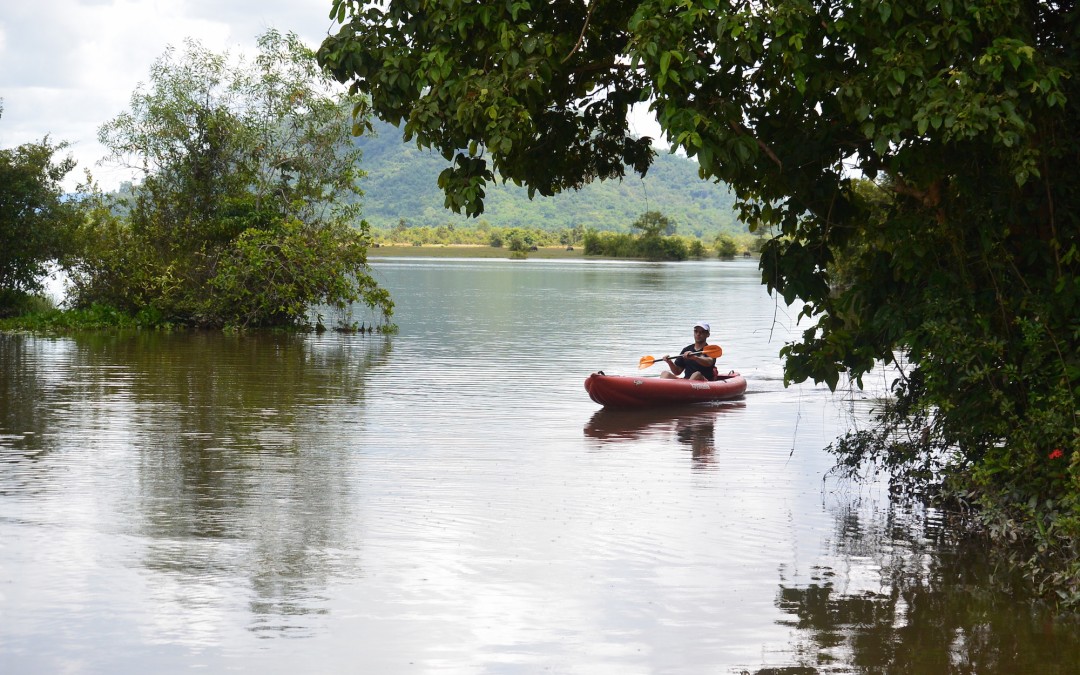
by Nick | Jun 6, 2019 | Angkor, Bike, Blog, Culture, Hike
HYDROLOGY MADE SEXY
Introduction
Angkor is an amazing place. You cannot fail to be impressed even stunned by the grandeur, detail and scale of the monuments. The true wonder of the Angkorian Empire and what it had achieved only started to dawn on me in the last few years. It was when the findings of the Lidar survey were published that I grasped the extent of what was one of the world’s greatest civilisations.
Lidar in layman terms emits an electromagnetic pulse – a laser that is strapped to a helicopter and fired as it passes over the ground to be surveyed. The reflected light is fed through software that strips away the vegetation to reveal the topography and previously unidentified structures.
The results are phenomenal! Phnom Kulen had a city on top. Angkor Thom was laid out in a grid of roads and canals framing wooden houses and their trapaeng or pools. There were thousands of temples not hundreds, and it was all made possible by the management of water in a climate where at the best of times 6 months of rain is followed by 6 months of drought.
I also began to realise that many of our cycle routes, hiking trails and even kayaking adventures followed these ancient waterways. I’d heard Roland Fletcher give fascinating talks at the Amansara Resort and on the banks of the West Baray. It wasn’t until Damian Evans (also from Sydney University) spoke to the guides I was managing that I knew he could tell us what we needed to understand Angkor.
The Water Connection
Boeung Ta Neue – our Secret Lake where we kayak, was an Angkorian reservoir formed by an extension of the North Wall of the East Baray, a much larger reservoir connected with the Angkorian cities of Ta Prohm and Angkor Thom. Boeung Ta Neue caught the rain run off from the
Kulen Hills to the North, which fed the Baray and in turn the conurbations of Angkor.
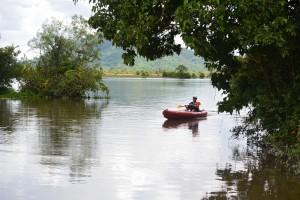 Kayaking on Boeung Ta Neue Angkorian Reservoir (Secret Lake)
Kayaking on Boeung Ta Neue Angkorian Reservoir (Secret Lake)
Nearby where the Baray finishes and the wall extension starts, is the 7 arched Spean Tor Bridge. Clearly visible by kayak from the water, we managed to reach it through the bush from the red earth road where Damian* had parked.
*Damian Evans archeologist working for Sydney University
We searched on the Baray side of the road for an exit but with none to be seen we couldn’t work out the purpose of the bridge though to be sure a thousand years ago it had one.
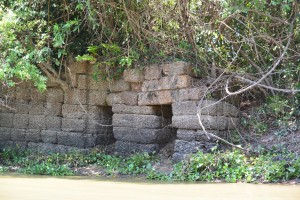 Spean Toh Bridge (named after the nearby temple Prasat Toh
Spean Toh Bridge (named after the nearby temple Prasat Toh
The main water flow into and out of the East Baray was through Kral Romeas, a sluice built into the banks of the East Wall. Cycling and hiking through Phum Samre, the village that lines the walls I’d noticed large laterite blocks and dismissed them as scattered from some Angkorian ruin, which they were. Closer inspection revealed 1 large thick wall and 30 metres away another running parallel forming two sides of the sluice. The raised ground in front of us was a laterite weir. Kral Romeas depending on time of year and water level, acted as an inlet and outlet to the East Baray and may have been connected by another laterite wall running parallel with the East Bank, to Boeung Ta Neue via Spean Toh.
An outlet has also been discovered opposite in the West Bank of the Baray, which fed into the Ta Prohm moat and then onto Angkor Thom. The East Baray at 14 square kilometers, 7km long and 2km wide would have supplied water to the two cities of Ta Prohm, Angkor Thom as well as the houses in between. It would also have been used for irrigation.
Damian explained the scale by comparing the East with the West Baray of similar size containing 50 million litre3 in the West Baray which provided irrigation for 5000 ha of rice, perhaps 10,000 tonnes for each crop. Feeding a population of hundreds of thousands of priests, the aristocracy and merchants who lived in and around these temple cities.
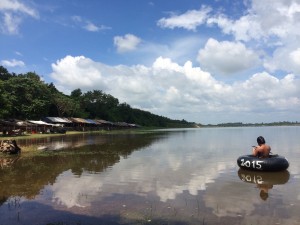 The West Baray at the end of the rainy season
The West Baray at the end of the rainy season
It was also unlikely that the 3 great water reservoirs of the West, East and North Barays were in simultaneous use but acted as a stabilising backup during times of drought and flood.
The scale of these man made hydraulics are unparalleled in human history and truly mind-boggling. The 3 spatial dimensions have to be combined with a 4th chronological dimension as the kings and climate changed over time. History seems to have been determined as much by the weather as the peaks in the empire. First during the reign of Suryavarman II in the 12th century then under Jayavarman VII in the 13th century, which coincided with the peaks in rainfall we saw from the ancient records on Damian’s computer screen and heralded the construction of the great temples of Angkor.
It is now suggested that the ultimate decline of Angkor was linked to periods of extreme drought followed by floods, which washed away the channels needed to supply water during the dry season. This is most clearly seen at Spean Thmor between Ta Keo and Angkor Thom where the old bridge lies high up the banks of the river now running meters below.
An as yet unexplained mystery is the adjacent 10 x 10 grid of a 100 mounds a few hundred meters from Prasat Toh. Similar grids have been found beside the ‘River of a Thousand Linga’s’ at Kbal Spean and Sambor Prei Kup near Kampong Thom, both associated with major water systems. No artifacts or remains have been found at either site that give any clues as to what the mounds are.
Walking through the site with Damian we spotted fragments of curved roof tiles in a papaya plantation that in an act of unintended vandalism, has been planted right over the mounds.
Most of what is known about Prasat Toh comes from a 4 sided stele (a stone pillar with carved enscriptions) discovered by the French in the 1930’s and now stored in The Angkor Centre for Conservation in Siem Reap. The Sanskrit engravings were translated and available on line. They explained that the stele had been installed by a Brahmin priest during the 13th century and referred to the Great King Jayavarman VII. The inscription mentions the Ganges River in association with water, which may have had something to do with the Kral Romeas sluice and was the same as an inscription found at Phnom Dai temple to the North, the site of another grid of mounds. The temple itself appears to predate the stele and is maybe contemporary with the 10th century East Baray.
 Prasat Toh and its 3 laterite towers situated near the North West corner of the East Baray
Prasat Toh and its 3 laterite towers situated near the North West corner of the East Baray
Randomly cast on the ground were the now eroded but once richly carved sandstone blocks that had adorned the structure including the stone crown that sat atop the central tower. Interestingly it had a hole in the middle, where a bronze finial in the form of a trident could have been positioned. Possibly removed at certain auspicious times of the year to bathe the Goddess Shiva sitting 15 meters below in sunlight.
Set amongst brilliant green paddy fields on the other side of Beoung Ta Neue is Leak Neang or Hidden Lady Temple. Dated to the 10th century and built at the same time as the spectacular brick temple of Preah Rup. A stele, which may give some clues to its origins has transferred to the Angkor Conservation for translation.
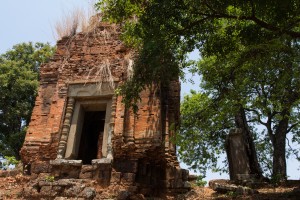 Leak Neang with its single brick tower
Leak Neang with its single brick tower
The bricks used in the construction of the structure are themselves a mystery as no kiln has ever been found. A theory speculates that the bricks were fired in a dedicated kiln close to the temples made of bricks, which were also used. The apparent black scorching seen on the walls seemed to support this idea.
Not only was this masterly management of water used to supply The Angkorians and irrigate their crops, it also conveyed the enormous amount of stone required to build the temples. Laterite is an iron rich clay that is soft and easy to dress into blocks when it comes out of the ground. On exposure to the sun it becomes very hard but relatively light making it ideal for the foundations but not the decoration as its pock-marked surface is not easily carved. The laterite quarries lay in the hills to the North West. Dams collected water from streams which was released into the Great North Channel that carried the stone blocks South to the North Baray from where they were used in the construction of Angkor.
At the Eastern end of the Kulen escarpment were quarries that supplied the sandstone, which was carved into the marvelous facades of the temples. As part of this network another channel ran from Beng Melea near the Eastern Kulen escarpment, past the Temples of Banteay Ampil and Chau Srey Vibol to Prasat Batchum inside Angkor Park. A path still connects these sites and makes for a great cycle ride.
We were beginning to get a handle on the Eastern end of the water connection, now it was time to explore the West. The Siem Reap River flows South from the Kulen Hills to the city and then onto the Tonle Sap Great Lake but during Angkor it was diverted into the North East corner of the Angkor Thom Moat. History is being repeated as subsequent to the floods of 2011 the channels have been reopened and another dug in parallel on the North side of the moat as the river is diverted into the West Baray with the aim of stopping the floods in Siem Reap. The fact that now the town of Puok to the West floods instead is not part of the discussion – tourists don’t go there.
Angkor Thom the largest of all the Angkorian Cities, was the capitol under Jayavarman VII. its wall’s 3km long enclose 900 hectares or 9 km2. Now forested but once the site of a thriving metropolis of wooden houses and trapeang (pools), surrounded by a grid of canals and roads as the Lidar survey revealed.
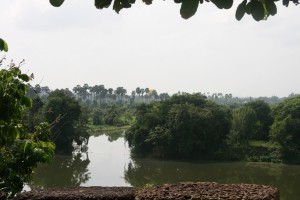 View over the moat from the walls at the S.E corner of Angkor Thom
View over the moat from the walls at the S.E corner of Angkor Thom
The data was detailed enough to show the individual houses, which can be extrapolated to give a guessed population of 70,000 based on an assumed family size. This would need a lot of water but during the rainy season any excess flowed out of Boeung Thom reservoir in the South West of Angkor Thom and through Runta Dev a canal that runs under the walls of the city into the moat. We’ve got a stunning cycle route that runs along the 8m high walls of Angkor Thom to Prasat Chrung or corner temple. A great late afternoon spot for watching the sun set over the moat, paddy fields and palm trees beyond. We didn’t realise the engineering marvel that lay 8 meters below us until Damian lead us down the inner banks to a stream that on closer inspection disappeared into a laterite tunnel under the walls and out to the glinting light of the moat 30m away.
The West Baray 500m to the West is yet another mystery. How was this vast body of water replenished and released during times of flood? The current outlet of the Angkor Thom moat is a canal running parallel with the road through the West Gate dug by the French, which destroyed any trace of what was there before. It is possible it was a replacement otherwise how did 50 million litres of water get into The Baray?
 Runta Dev runs under the walls of Angkor Thom
Runta Dev runs under the walls of Angkor Thom
What had we learnt that morning?
We understood that water running off the Kulen Hills to the North fed streams, which flowed into the reservoir of Beoung Ta Neue in turn feeding the East Baray, which was a water supply for the population of Angkor Thom and Ta Prohm.
Damian confirmed that our cycling path to Chau Srei Vibol and on to Banteay Ampil, lay along the route a canal had taken bringing sandstone from the quarries at the Eastern end of the Kulen escarpment via Beng Melea to Angkor.
He explained how the laterite blocks used to build the foundations of the Jayavarman VII temples were carried by water released into the Great North Canal which flowed from the quarries at the Western End of the Kulen Hills to the North Baray and father temple of Preah Khan.
And the Western hydrological connection was made by the Siem Reap River coming from the Western end of Kulen flowing into the Angkor Thom moat and maybe on into the West Baray.
And much else besides!
With great thanks to Damian Evans for a really fascinating morning and apologies for any misinterpretations.
Indochine Exploration with Smiling Albino Cambodia is pleased to take our guests on a introductory investigation of the main temples along the water courses described or an adventure to experience this incredible landscape on foot, by bicycle or kayaking.
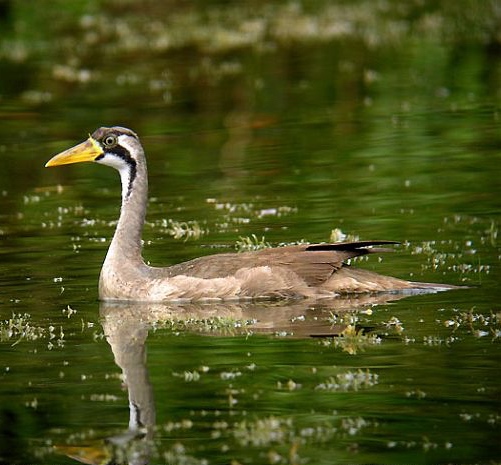
by Nick | Feb 22, 2019 | Blog, Cambodian Journeys, Kayak, Uncategorized
finfoot
1. The finfoot is Hatched
finfoot was born in Prek Toal and conceived in the myriad of marshy waterways that come and go with the flood and ebb of the lake across the floodplain.
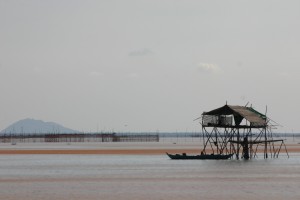
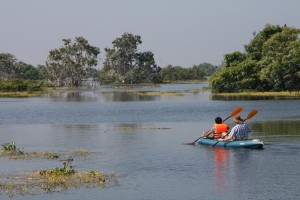 The Tonle Sap Lake during the ebb and Prek Toal Core Bird Reserve (below)
The Tonle Sap Lake during the ebb and Prek Toal Core Bird Reserve (below)
The Masked finfoot is a shy and reclusive water bird skulking in the marshy vegetation lining rivers and lakes. Spotting the bird is a rare and wonderful experience, which seemed a good enough reason to call our boat finfoot (masked is too difficult to pronounce).
 Early morning egrets in the Core Bird Reserve
Early morning egrets in the Core Bird Reserve
I came to Cambodia as a volunteer business advisor to a French NGO. The aim was to provide alternative livelihoods for the families we were working with on the lake. One of these livelihoods was ecotourism but they hadn’t got any guides, hence my first encounter as a bird guide with The Tonle Sap Lake and Prek Toal Core Bird Reserve.
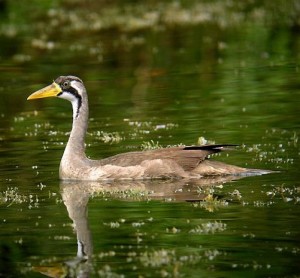 Masked Finfoot Hellopais personatus
Masked Finfoot Hellopais personatus
I didn’t know anything about either but was overwhelmed by the spectacle of the place.
Years spent in Cambodia passed by but my love affair with the lake remained. The phenomenal change driven by the backflow from the Mekong River was maybe reminiscent of the massive tidal zone around Jersey where I’d spent my childhood holidays. The extent of the lake and its inaccessibility, but not if I had a boat!
We’d got something to go on. The uber luxury resort Amansara had a boat called Amanbala. She was the brainchild of Sally the GM and a friend, so not to be copied while she was here but now she’s long gone, fair game.
We started with a wooden hull that seemed enormous and a rusting tangle of metal passing as an engine. It had towed a wedding platform from Prek Toal to the mouth of the fishing channel that leads to Maichrey when we staged the Bill Bensley Boat Races.
The message from our Thai business partners was full steam ahead, just put a business proposal together. So Buntha and I set off for Prek Toal. Buntha’s brother in law, the BiL, in more prosperous times had been a fish merchant as well as crocodile farmer. Moored behind his house was the hull. Once a container for transporting fish across the lake to Chong Khneas where some of the cargo made it to Thailand or Vietnam, while the rest rotted back to where it came from.
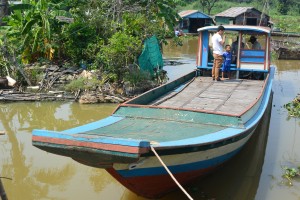 finfoot as it was behind the BiL’s house
finfoot as it was behind the BiL’s house
The BiL connected a big battery to the engine, turned a key beside the Camry steering wheel and the machine roared to life. We nosed round the Chheang collection of floating houses into the main channel. The boat was steered by ropes connected to a long tailed propeller shaft that slowly shifted it in the desired direction. There was no cover or sound proofing but the powerful sound of the big V6 engine was infinitely preferable to the minding numbing cacophony of the 2 strokes that drove the fiberglass long-tails screaming through the village.
Safely away from where our wake could do no more than shake a floating carpet of vegetation, the BiL pushed forward the throttle and the boat took off! The distant lake rapidly loomed large as we almost planed towards it. Two tons of solid wood doesn’t exactly lend itself to planing. The fuel gauge if we’d had one would have been spinning as litres of diesel exploded in the cylinders.
That was last year – 2017, when the lake reached its zenith. This year – 2018, as the water and our guests receded my focus returned to the boat. I put the requested proposal together for our business partners and waited for the green light but after umpteen revisions the light went orange and finally nothing at all.
The dry season window was evaporating when the boat builder could work all day, and most important the next tourist season looming.
I was back in the UK and weary with the sound of my own enthusiasm coming to nothing so the project stalled. Skip a month to Menorca, a weekend away with Laura an industry friend and her pal Duncan. ‘Tell us about your boat,’ they said so I did. ‘We’ll give you 25% – each.’ Ok so the projects incubating. ‘I will too,’ said my brother and the egg was on its way. Another investor in Siem Reap had agreed to 25% but that was talk so the last share became mine.
‘Buntha what’s happening with the boat?’ Was nearly the first question I asked when I got off the airplane from the UK, ‘nothing Bong,’ ‘well let’s make it happen.’ So we did. Mr fixit AKA Buntha found the boat builder at the tourist port of Chong Khneas, who’d built the Amanbala for Amansara.
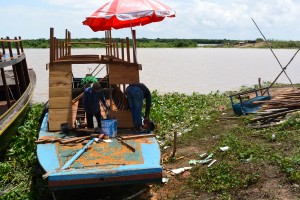
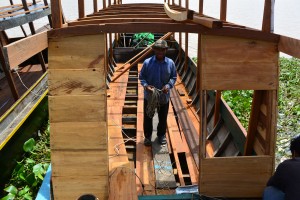
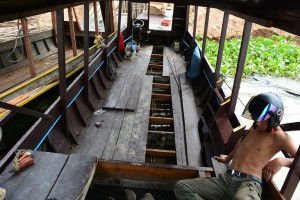
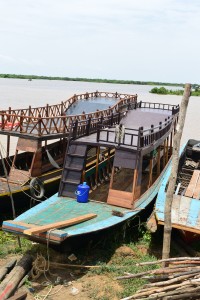 The metamorphosis of finfoot
The metamorphosis of finfoot
We forced our way through the tourist port, ‘not come here,’ the check point charlie ordered. ‘I’m not a tourist, I’m having a boat built.’ My Khmer didn’t cut any ice, I was white and therefor a tourist. I sat and glowered at him until the boat builder fetched me to see what would become a finfoot. We agreed a price, paid him something to show we were serious and that was actually that. Weekly visits to watch the metamorphosis of the bare wooden bones into finfoot went incredibly smoothly such that within a couple of months she was born.
2. finfoot flies
Our Team together with Joni, the GM of Treeline, friend and witness went to Chong Khneas as apparent tourists. Well that’s how Joni & I appeared, the rest are Khmer. We were herded down the gangplank onto the boarding platform and whichever tourist boat and disinterested driver we were to be allocated with. ‘We have a boat,’ I dismissed some tout having spied Heang our captain and finfoot moored and ready, then with a huge surge of pride stepped onboard.
finfoot powered across the floodplain with its big six cylinder lorry engine. Out on the open lake I took the wheel, opened the throttle and felt a surge of oomph. There was still another 30% to go. Our direction towards the forest was slightly disconcerting, I thought as I tried with no effect to correct it. Heang you’d better takeover, I suggested. It steers a little to the right. ‘Yes Bong,’ as if to say that’s why I’m the captain.

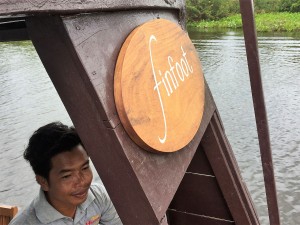 My efforts as Captain and Heang correcting them
My efforts as Captain and Heang correcting them
We moored at the mouth of the Maichrey channel, opened a bottle or two of Prosecco and took self-congratulatory photos.
The Team felt good and on the way back Lors was trying to engage Joni with the usual Khmer chat up line of why aren’t you married, not known for its subtlety. Grasping that the approach wasn’t going well he changed the subject. ‘How do you spell biopsy Nick?’ Sadly his mum had a breast tumor. Tiger grinning, ‘how do you spell f – – – Nick?’ ‘Not sure Tiger, ask Joni,’ even Lors laughed.
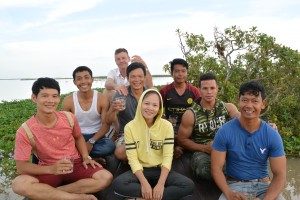 The Team (left to right) Bunthy, Tiger, Me, Buntha, Sreymom, Heang, Lors & Ra
The Team (left to right) Bunthy, Tiger, Me, Buntha, Sreymom, Heang, Lors & Ra
I wanted a space where Dean our partner in cocktails and canapés could work his magic so I commissioned Oyen the cabinetmaker to make a bar with an inset sink behind. Dean had to see it so just before setting off to the UK, Dean & Buntha together with Tiger & I launched our kayaks behind Phnom Kraum and paddled 10km to where the Maichrey Boat Station should be.
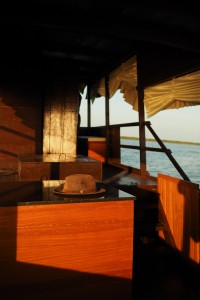
Deans bar
It started this year with a dam across the Mekong collapsing in Laos just North of the border with Cambodia. The surge of water that flooded down the river kicked off the backflow up the Tonle Sap River, which in turn flows into the Tonle Sap Lake. Heavy monsoonal rains filled the tributaries adding to the tsunami of water that was swelling the lake near to where it had risen in 2011. We glided across what was and soon will be again the semi-swampy floodplain straight to the boat station except the road was now flooded and the tourist boats were moored in the grounds of the local pagoda, usually a kilometer away. Tiger reappeared with a cold beer, my hero then the van bearing our guests and Dean’s cocktails arrived.
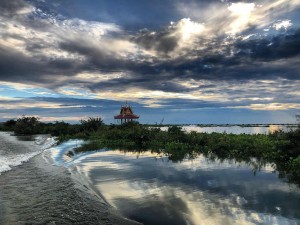 Naida’s IPhone photograph of the lake as we headed back to the pagoda
Naida’s IPhone photograph of the lake as we headed back to the pagoda
Moored behind a semi-submerged tree, we finished Dean’s cocktails as the sun sank through strata of cloud. Then Naida and the boys moved onto neat gin. We’d run out of tonic.
3. The final fit-out
Yes, yes, yes, said the fabric lady, when I explained that we wanted her unsightly but protective plastic curtains rolled up and wrapped in our beige canvas. The result was reminiscent of a 1970’s B&B in Aberystwyth and I should know, I’d lived in one! We’d also commissioned a canopy for the top deck to shade the mattresses she was going to make. The canopy remained elusive and the mattresses bore no relation to the space where they were to fit. She the fabric lady had sent someone to fit it all out but I don’t think they could count and I had to pay for the changes as she’d got our material that we’d sourced from Australia.
Meanwhile Oyen the cabinetmaker had finished everything he said he would by the time he said, though his daybed collapsed when he sat on it (he quickly came back to fix it). A ships wheel not the steering wheel of a Toyota Camry, the usual method of changing direction for most boats on the lake. I’d managed to find one at a ships chandler in Newhaven, Sussex along with the LED lights we needed for our sunset cocktail trips.
October last year I was back in the UK having one of our weekly Skype calls with Buntha. ‘Bong I’ve got good news and bad,’ or words to that effect. ‘Yes?’ ‘Well which?’ ‘Bad news,’ ‘the engines broke,’ ‘go on,’ I said, just in case you’ve lost the thread of this conversation. As soon as the subject gets technical English ceases to be an effective vector for communication. ‘So what’s plan B?’ I asked. One of the great things about Buntha is he has plan B’s. ‘I’m going on holiday.’ He didn’t actually say that but that’s what happened. He and the mechanic first went to Battambang no luck then to Phnom Penh. Bingo they got the required widget, something to do with the gearbox, and returned. Widget cost $250, traveling costs $250, fixed engine priceless and $900 cheaper than the ‘Bong it’s going to cost $1500.
4. Finfoot adventures
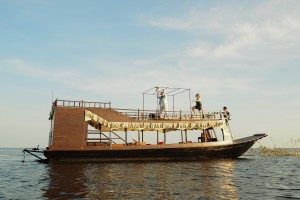
Stephanie and Jules from Bangkok together with Manus & I photographed by Serey and spoiled by frilly curtains
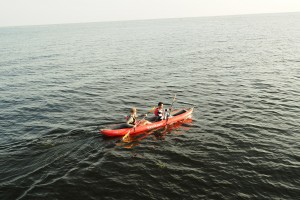

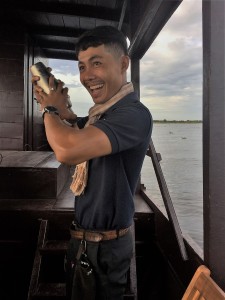 Christian + partner with Tommy on the top deck while Tiger mixes martinis by the bar
Christian + partner with Tommy on the top deck while Tiger mixes martinis by the bar
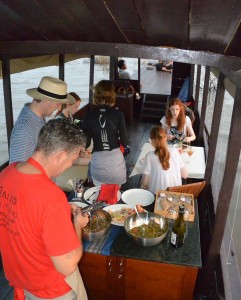 Christmas eve BBQ on board (you can just notice the correct curtains)
Christmas eve BBQ on board (you can just notice the correct curtains)
Our finfoot adventures had been piling up since that happy day we set off on our maiden voyage. It had been a hard week, the constant stress of our impending Smexit (a legal separation from our business partners) and a whole host of other obstacles real or imagined. We needed an excuse to get out of the office.
Manus uncharacteristically turned up on time so we; Buntha, Ra, Lors, Jin and Tiger with Manus set off to recce a big gay wedding party booked for next month.
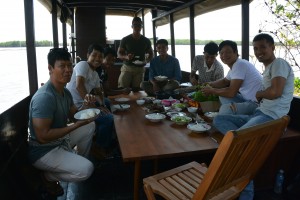 Left to right; Ra, Tiger, Heang, Lors, Jin, Doitch (our van driver), Buntha and Manus
Left to right; Ra, Tiger, Heang, Lors, Jin, Doitch (our van driver), Buntha and Manus
The context was Bill Bensley’s Boat Races in 2013 https://indochineex.com/blog/bill-bensley-boat-races-indochine-exploration
We had towed a wedding platform 15km from Prek Toal to Maichrey. His staff raced traditional water festival racing boats, while our muscle boys, ten of them including Manus, paddled Bill’s inner circle between the racing boats. A photo of Little Tee (left in 2013) and his biceps sold the trip this time so a newly married gay couple will use us to set up a party, with muscle boys on a platform at the edge of the lake.
The issue was the platform we’d used before had sunk when they drove a Caterpillar earthmover on it, so our mission today was to find another one. A job for the Sisters of Mercy and their volleyball court, unfortunately it was holding up the school, which wouldalso sink if we towed it away. Buntha had yet to come up with plan B.
Lors had a chicken smoking on the BBQ, Ra laid the table, Tiger took his shirt off, Jin blended into the background, Buntha sorted out the Sisters of Mercy while I relaxed with Manus and thought about our next adventure, a night on the lake with Manus on finfoot.
‘I want to sleep on the boat,’ Manus told me, and so did I but customers got in the way until the staff lunch.
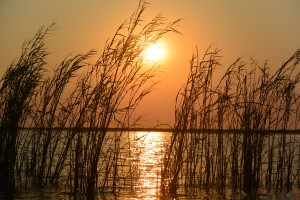
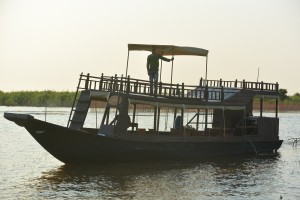 Sunset on The Tonle Sap Lake
Sunset on The Tonle Sap Lake
Upstairs or downstairs was the question. Cool with a view was the answer until I thought about falling off when I need to piss in the middle of the night so we strung up a mosquito net above the downstairs daybed.
Our rival operator as in David and Goliath, where we play the role of David, had kindly constructed and conveniently situated a small platform where the Maichrey Channel meets the Tonle Sap Lake.
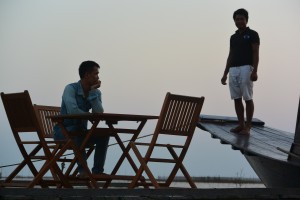 Manus on Goliath’s platform and Heang on the prow of finfoot
Manus on Goliath’s platform and Heang on the prow of finfoot
Heang moored finfoot alongside and I set off in a kayak to watch the sun sink into the Lake. The fishing season has started so the lakeshore is fringed with a maze of fishing nets designed to catch fish, not kayaks presumably. It was a puzzle how to avoid being funneled towards the trap where the unfortunate fish end their life’s journey.A few weeks ago quiet would have settled on the still waters as the sun sank now the staccato clap of 2 stroke engines reverberated as the fishing boys took watch.
A golden path lead from the West to finfoot and our platform for the night, where Manus had a set up a table and chairs. Heang was cooking. I’d forgotten any oil so he was braising our chicken in Cambodia beer, in the meantime I’d bought a bottle of champagne.
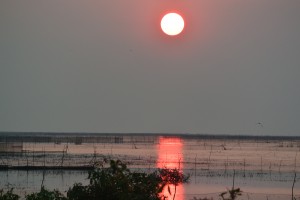 February sunrise over the Lake
February sunrise over the Lake
Heang and Manus sat on the platform as dusk descended and I popped the cork on a bottle of Moet. Manus likes champagne and so unfortunately did Heang, which meant there was a little too much sharing and not enough beer afterwards because it had been poured on the chicken!
It was cool so Manus and I curled up together. The precautionary Valium induced a soothing torpor little penetrated by the predawn clatter of fishing boats. Manus sweetly bought me a mug of tea when I woke and we watched the sunrise through the fishing fences from the East.
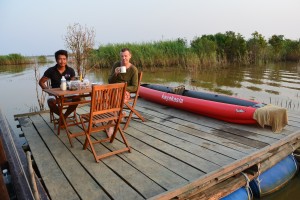 Breakfast on the Lake
Breakfast on the Lake
A couple of coffee’s later we reluctantly headed back. We’d missed the sweet spot when the lake’s high and the fishermen are back in the village mending their nets but it was still a beautiful experience.
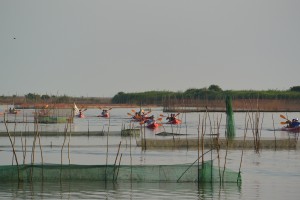
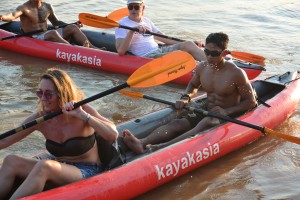
Philip and Stefan’s wedding party a couple of weeks later amongst the fishing fences and Mali the muscle boy with one of the guests
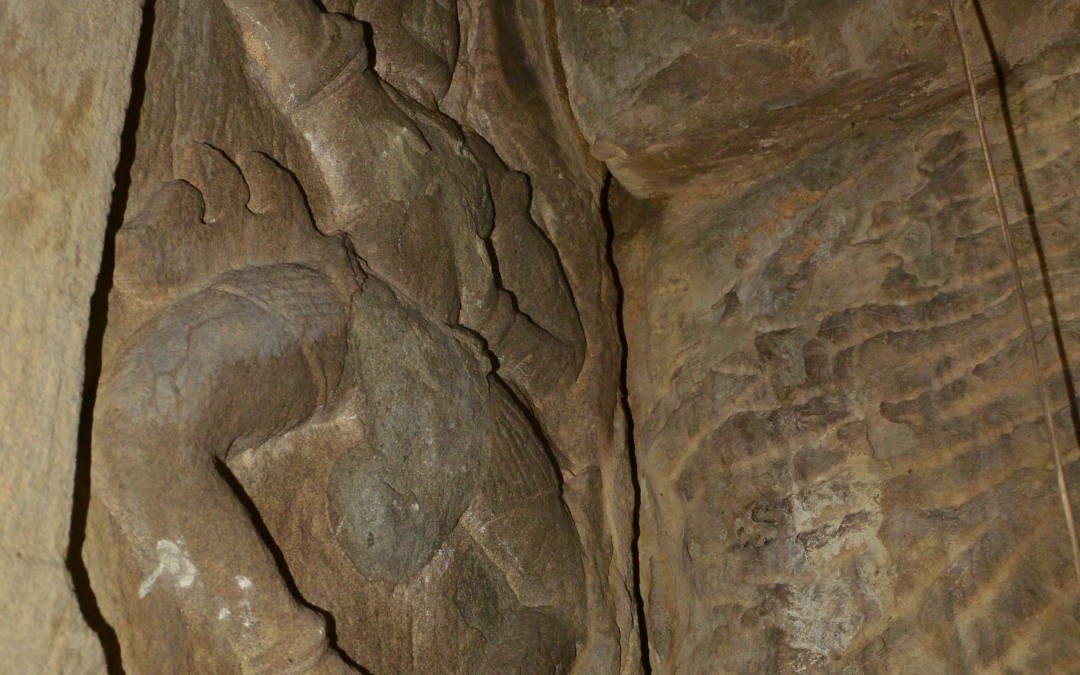
by Nick | Jan 11, 2019 | Angkor, Blog
Christmas Lunch in Prasat Pong Keou Temple
In the glory days of our romance with Amansara* we had helicopters and oxcarts to and from the Tamarind Temple in the city of Angkor as a standard trip. Last year Apsara, the temple authority built a road and put an end to our white tablecloth champagne temple lunches. So we needed a new one – temple that is.
*The uber luxury Siem Reap Resort
It all started 8 years go when a monk came to see me about a forest and we discovered a temple ………..
Skip 8 years and we were trying to find it again not helped by its many names. Prasat Yoni or Temple of the Vagina being the most mentioned. Our adventure guide was given the mission and came back with a photo and tales of a temple but not the one I remembered.
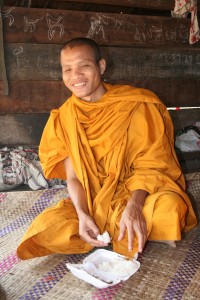 Chum Nean the monk, who in 2010 was trying to protect his village from the encroaching rubber plantation and took me to Pong Keou
Chum Nean the monk, who in 2010 was trying to protect his village from the encroaching rubber plantation and took me to Pong Keou
Yet another year and now motivated by an enquiry for a temple lunch we set off as a team on mountain bikes through the bush. Armed with local knowledge gleaned from villagers on route, we came upon a patch of forest but still no sight of it. Then hacking through the vegetation with machetes the laterite walls appeared.
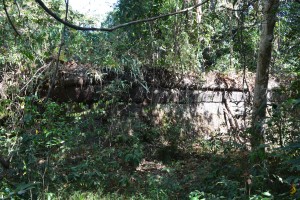 Our first sight of Prasat Pong Keou in August 2018
Our first sight of Prasat Pong Keou in August 2018
Skip to October at The Ivy Restaurant in Chelsea and a lady called Di who had a client called Peter and we’ve almost got to the start of the story on Christmas Eve. But not so fast, there was a helicopter to organize. It seemed simple in August when we first found the temple but by October when we went to choose a place to land and record the GPS coordinates, the dusty dry countryside had become a large lake. Forget helicopters kayaks would have been more useful, we went back again at the beginning of December to choose the landing site.
Let me introduce the supporting cast for this performance; Ra our temple host, Buntha AKA Mr Fixit, Miss Wong master chef Dean. Then there was Black-dog the van driver and Bong Kroyun, who steered the tractor or kroyun *and Mr Pal who made mince meat of helipad construction. Oh and myself. My main job was to panic and pester to the point where it was easier to get the logistics sorted than put up with me.
*kroyun lit. motorised buffalo cart
Things go at their own pace, to be messed with at your own peril or most likely slowing down whatever you want speeded up. So while I hadn’t a clue why we were waiting at Buntha’s house in Samrong his village on Christmas Eve, it became clear as events took their own course.
Logging, encroaching agriculture and forest fires had taken their toll since we last visited. The paths looked different and we went down the wrong one. Not an auspicious start to our big adventure.
Who was our guest? I can’t really say, client confidentiality and all that but suffice to tell his online profile was considerable and intellectually engaging. The rest of his family; Sarah his wife and 3 fey daughters, Princesses sheathed in gossamer gowns, crowned by coronets – lady’s of the lake.
Mr Pal, Buntha, Black-dog and myself hacked our way through the undergrowth, finally glimpsing the blocks of laterite that made up the walls of the etheral Prasat Pong Keou, as much a myth as reality. As if that wasn’t hard enough termites had colluded to prevent entry. There was a tantalizing peek at the West entrance but short of wriggling across a bed of ants no way in. Illegal logging and vandalism had bulldozed a hole in the wall to get at a valuable rosewood tree, our necessary entry point.
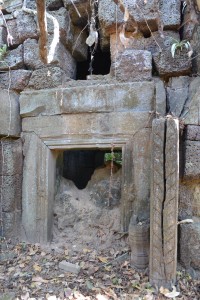 What used to be the entrance to Prasat Pong Keou
What used to be the entrance to Prasat Pong Keou
The gash in the wall was like a link in time to a thousand years ago when a different world was inhabited by a culture that hadn’t yet outgrown its environment. A microclimate of intense humidity and heavy mystery hung over the ancient remains of what the kroyun driver told us was a halfway house along a long gone Angkorian road between the major temples of Koh Ker and Beng Melea. Our presence was like a warp in time but not space as we carefully cleared away the secondary growth since whoever had been here last.
Tripping over tilting stones we found a central tower block with multiple entry points. One lead to a blind chamber adorned by primitive Apsara*. Four had been defaced but the furthermost corner carving had escaped the vandals. Fern fronds hung from the temple terraces like they were planted at a Chelsea Flower Show feature garden.
*Celestial dancers
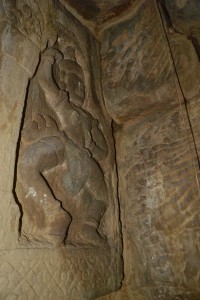

Unique Apsara (left) and the central tower block at Prasat Pong Keou (right)
More to the point where were we going to balance the table and chairs for Christmas lunch? We retreated to clear a route through the vegetation and coarse grass back to the rutted laterite road we’d left. We saved the helipad for the next day. We leap frogged each other as our motorbikes took it in turns to get punctures and made it back to Buntha’s house in Samrong.
A house if you’re lucky enough to have one is just a space in Cambodia. We furnish and decorate our rooms according to what we’re going to use them for in a way that pleases us. In Cambodia if you want to wash you find a space where you can scoop water from a pool. If you want to cook you use a clay charcoal pot to boil or fry whatever you’re cooking. And when you want to sleep you roll out a mattress, hang a mosquito net and if you’re lucky position a fan. In spite of or because of this different approach I lay on my comfortable mattress in relative cool, clean and well fed.
Christmas morning and there was a kroyun* where Buntha had organized one to be and another on its way so we set off to scythe rice straw. I seemed to miss the straw and hit worm mounds sending the blade flying from its handle and quickly turning the callus on the palms of my hands into blisters. I realized that my future career didn’t lie with rice farming.
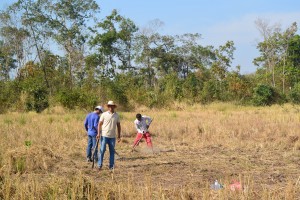 Preparing the helipad; Buntha (left), Mr Pal and Bong (Brother) Kroyun
Preparing the helipad; Buntha (left), Mr Pal and Bong (Brother) Kroyun
I was much better at making an H. It started as an H but we cleared some more rice stubble so added an I and connected it to the H with a hyphon = I-H. Since our retiring temple seemed to change location each time we visited I went to check that it was still there and see if I was better at hacking vines than rice straw.
Dean had arrived on the second kroyun, so we ported the provisions through the gap in the walls and proffered the stage from which he was going to work miracles, so far so good. We cycled back to the helipad to see if the helicopter carrying our precious guests had arrived.
Meanwhile the rice farmer whose field we’d appropriated had turned up. He’d heard on the jungle grapevine that a barang* was digging up his land. Pacified by Buntha he saw instead that we’d cut his straw for him so he retreated to a safe distance to watch the fun with his wife.
A while later a whir could be heard across the forest and the speck in the sky materialized into our aircraft. It circled the landing site a couple of times, deciphered my I-H and descended amidst a blitz of rice straw.
*barang lit. Frenchman but used as a general term for all white foreigners
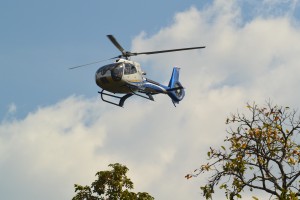
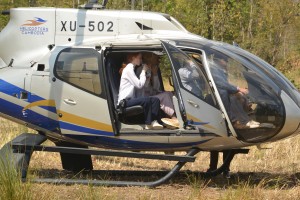 Our guests approach and land
Our guests approach and land
“Mr Fletcher I presume,” I’d been saving it up for a long time. “Good to meet you,” he generously replied. We arranged his family on the kroyun trailer and set off on the trail for lunch.
It had been a good call to mechanically convey these gentle creatures rather than line up mountain bikes and expect them to wade through the sand. A chain of boys was waiting to guide them through the laterite portal to where Dean like a big mother hen dispensed cold towels and bonhomie. “Your temple.” There was a collected wow before they started exploring its nooks and crannies then settled for champagne and turkey.
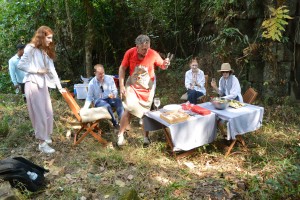 Mr Wong performing Christmas culinary magic inside the temple
Mr Wong performing Christmas culinary magic inside the temple
I sat slightly aside on a stone with a glass of Moet and for the first time in 36 hours started to relax. The Moet gone and half a bottle of Dean’s Prosecco later, I was definitely relaxed as I said goodbye to the guests. Replete with the considerable remnants of the guest lunch, the ‘team’ lined up to convey the cool boxes and general paraphernalia back to the kroyuns.
Buntha and I raced ahead on mountain bikes too elated to notice the clogging sand we glided over. We caught a glimpse of the helicopter circling above the trees and that was the last we saw of our guests for Christmas lunch at Prasat Pong Keoy.
As a footnote the kroyun drivers were well rewarded and anybody to hand back at Ta Siem Village got a can of soda. Everyone involved in the undertaking was generously tipped. ‘Could we do it again Buntha?’ ‘Yes,’ he said confidently, ‘we’d just have to pay more.’
I received several messages that night from Mr Foster – not his real name thanking us for an extraordinary event. Di had asked for something that nobody else had done before. It’s very unlikely that in the temple’s thousand year old history anybody has had Christmas lunch there, especially not a family from London.

 The outer corridor alongside the Churning of the Sea of Milk
The outer corridor alongside the Churning of the Sea of Milk Ravana an Assura (demon) with the head of Vasuki (snake king)
Ravana an Assura (demon) with the head of Vasuki (snake king) Buxom nymphs or Apsara arising out of the seminal fluid in anticipation of amrita
Buxom nymphs or Apsara arising out of the seminal fluid in anticipation of amrita ![]() Vishnu sitting on his avatar (reincarnation) the Turtle encouraging the tugging Divas (Gods)
Vishnu sitting on his avatar (reincarnation) the Turtle encouraging the tugging Divas (Gods)  All the creatures of the ocean getting churned in the Sea of Milk
All the creatures of the ocean getting churned in the Sea of Milk Hanuman, the monkey god making sure the Divas keep tugging
Hanuman, the monkey god making sure the Divas keep tugging

 Angkor Thom Moat, one of the great waterways that maintained ground water below the temple and prevented subsidence
Angkor Thom Moat, one of the great waterways that maintained ground water below the temple and prevented subsidence Runta Dev, the tunnel under the 8m high walls of Angkor Thom that channeled waste-water out of the city into the moat
Runta Dev, the tunnel under the 8m high walls of Angkor Thom that channeled waste-water out of the city into the moat Peou overseeing our progress up the North Baray Channel
Peou overseeing our progress up the North Baray Channel Peou and Jady with Buntha contemplating our adventure
Peou and Jady with Buntha contemplating our adventure Paddling down the Siem Reap River
Paddling down the Siem Reap River 
 Miranda de Ebro Station
Miranda de Ebro Station


 View up the valley from Borreda (It’s pretty countryside)
View up the valley from Borreda (It’s pretty countryside)

 Saint Sadurni de Rotges
Saint Sadurni de Rotges A Swallowtail butterfly
A Swallowtail butterfly Emballisment de Baels
Emballisment de Baels The Church at La Nou
The Church at La Nou In the mountains of Nou with my Trek
In the mountains of Nou with my Trek Borreda and its history on a mural in the centre of the village
Borreda and its history on a mural in the centre of the village La Pobla
La Pobla
 Kayaking on Boeung Ta Neue Angkorian Reservoir (Secret Lake)
Kayaking on Boeung Ta Neue Angkorian Reservoir (Secret Lake) Spean Toh Bridge (named after the nearby temple Prasat Toh
Spean Toh Bridge (named after the nearby temple Prasat Toh The West Baray at the end of the rainy season
The West Baray at the end of the rainy season Prasat Toh and its 3 laterite towers situated near the North West corner of the East Baray
Prasat Toh and its 3 laterite towers situated near the North West corner of the East Baray Leak Neang with its single brick tower
Leak Neang with its single brick tower View over the moat from the walls at the S.E corner of Angkor Thom
View over the moat from the walls at the S.E corner of Angkor Thom Runta Dev runs under the walls of Angkor Thom
Runta Dev runs under the walls of Angkor Thom

 The Tonle Sap Lake during the ebb and Prek Toal Core Bird Reserve (below)
The Tonle Sap Lake during the ebb and Prek Toal Core Bird Reserve (below) Early morning egrets in the Core Bird Reserve
Early morning egrets in the Core Bird Reserve Masked Finfoot Hellopais personatus
Masked Finfoot Hellopais personatus finfoot as it was behind the BiL’s house
finfoot as it was behind the BiL’s house


 The metamorphosis of finfoot
The metamorphosis of finfoot
 My efforts as Captain and Heang correcting them
My efforts as Captain and Heang correcting them The Team (left to right) Bunthy, Tiger, Me, Buntha, Sreymom, Heang, Lors & Ra
The Team (left to right) Bunthy, Tiger, Me, Buntha, Sreymom, Heang, Lors & Ra
 Naida’s IPhone photograph of the lake as we headed back to the pagoda
Naida’s IPhone photograph of the lake as we headed back to the pagoda


 Christian + partner with Tommy on the top deck while Tiger mixes martinis by the bar
Christian + partner with Tommy on the top deck while Tiger mixes martinis by the bar Christmas eve BBQ on board (you can just notice the correct curtains)
Christmas eve BBQ on board (you can just notice the correct curtains) Left to right; Ra, Tiger, Heang, Lors, Jin, Doitch (our van driver), Buntha and Manus
Left to right; Ra, Tiger, Heang, Lors, Jin, Doitch (our van driver), Buntha and Manus
 Sunset on The Tonle Sap Lake
Sunset on The Tonle Sap Lake Manus on Goliath’s platform and Heang on the prow of finfoot
Manus on Goliath’s platform and Heang on the prow of finfoot February sunrise over the Lake
February sunrise over the Lake Breakfast on the Lake
Breakfast on the Lake


 Chum Nean the monk, who in 2010 was trying to protect his village from the encroaching rubber plantation and took me to Pong Keou
Chum Nean the monk, who in 2010 was trying to protect his village from the encroaching rubber plantation and took me to Pong Keou  Our first sight of Prasat Pong Keou in August 2018
Our first sight of Prasat Pong Keou in August 2018 What used to be the entrance to Prasat Pong Keou
What used to be the entrance to Prasat Pong Keou

 Preparing the helipad; Buntha (left), Mr Pal and Bong (Brother) Kroyun
Preparing the helipad; Buntha (left), Mr Pal and Bong (Brother) Kroyun
 Our guests approach and land
Our guests approach and land Mr Wong performing Christmas culinary magic inside the temple
Mr Wong performing Christmas culinary magic inside the temple